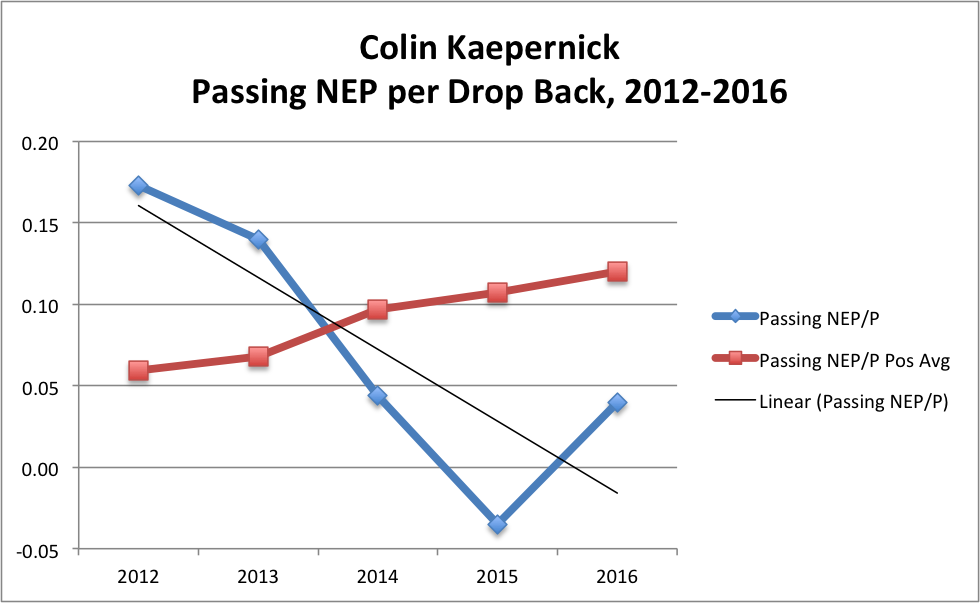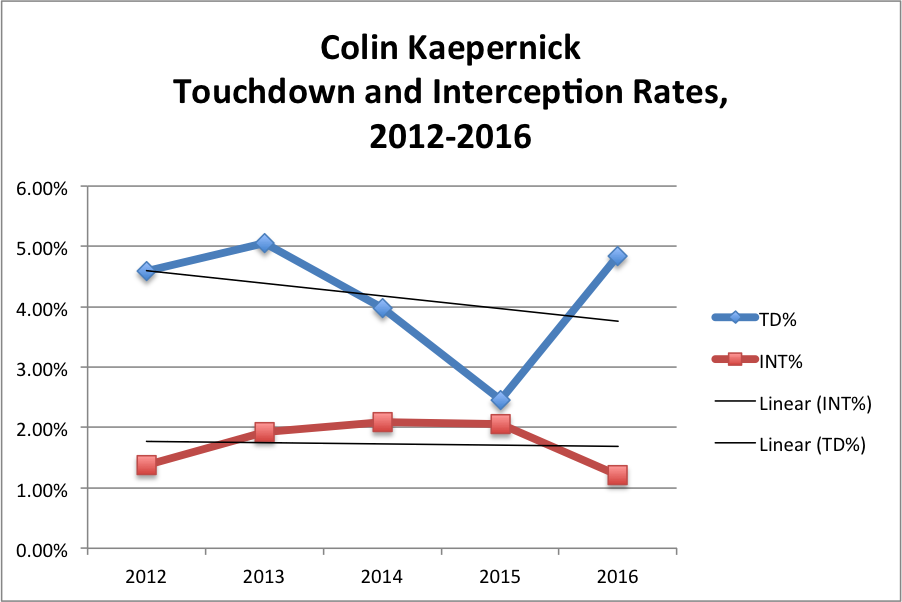Colin Kaepernick Still Has Value as an NFL Free Agent

Last week ended the spectacular saga of quarterback Colin Kaepernick's tenure with the team that drafted him, the San Francisco 49ers.
During his time with the team, the highest of highs in reaching Super Bowl XLVII were combined with the lowest lows in being benched for the ghost of an NFL quarterback calling itself Blaine Gabbert at points over the last two seasons.
No one can dispute that Kaepernick was -- and still is -- one of the most exciting and polarizing players in the NFL, both on and off the field, but where does he go after opting out of his contract with the Niners?
What does the future hold for Kaepernick as he navigates free agency for the first time in his career?
Reading the Tea Leaves
One of the heartening things about Kaepernick’s departure from the 49ers is that he himself opted out of his contract. The team, it seems, would have been -- and may still be -- willing to bring him back (albeit likely on a reduced deal).
Instead, Kaepernick is trusting in himself in the free agent market and angling for a starting job somewhere in the league.
How much trust should he have?
Kaepernick’s quarterback play has declined nearly every year he’s been in the NFL. We can see this depicted through the use of numberFire’s signature analytic: Net Expected Points (NEP). NEP is an analytic that describes the contribution a play (or player) makes to their team’s chances of scoring. By adding down-and-distance value to standard box score information, we can see just how much each play and each team as a whole influence the outcome of games. For more info on NEP, check out our glossary.
Kaep’s Passing NEP per drop back has slid downward each year from his 2012 starting debut (0.17) to 2015’s benching for Gabbert (-0.03). All the while, the NFL’s average Passing NEP per drop back has risen steadily every year, from 0.06 to 0.11 over those four years. The graph below shows these trends across the last five years of Kaepernick’s career.

So, while the league as a whole steadily improved, Kaepernick’s passing prowess did the opposite as the league figured out his tricks and took those tools away. If you’ll notice, though, the final year on the graph showed a stark rejection of the dominating trend. Last season saw Kaepernick claw back from the negatives to post a bad (but not straight-up awful) 0.04 Passing NEP per drop back -- nearly identical to his value production rate in 2014.
This bounce-back season forces us to ask what caused Kaepernick to be so bad in 2015, and whether it’s a blip on the radar or a sign of better times to come.
When we look at Kaep’s touchdown and interception rates over the last five years (the percent of pass attempt on which he’s thrown a touchdown or interception), we can see some of why his passing value trend reversed. The graph below shows these rates.

Kaep was lighting up defenses for his first two years, with touchdown rates nearing 5.00 percent, but he declined in 2014 and hit bottom in 2015 with a 2.46 percent mark. Simultaneously, his interception rates climbed from a sparkling 1.38 percent in 2012 to above 2.00 percent in two of the next three years.
A lot of this has to do with the offense assembled around him, and the departure of a great coaching staff led by Jim Harbaugh. In 2015, leading receiver Michael Crabtree departed in free agency, as did stalwart running back Frank Gore. Without the reliable target of Crabtree and a top-tier running back like Gore to take pressure off the man under center, Kaepernick was hung out to dry. Add in the carnival that was the Jim Tomsula head coaching tenure, and it was a recipe for failure.
In a strong offense-centric system last year, though, Kaepernick flourished once more. His touchdown rate skied to 4.83 percent, and his interception rate dropped back to a career-best 1.21 percent.
With the personnel around him largely the same from 2015 to last year, what caused the change?
Kaepernick returned to a more aggressive approach last year under head coach Chip Kelly, allowing him to buy time with his legs, use play-action and read-options, and heave downfield.
Pro Football Focus’s average Depth of Target (aDOT) helps us to see Kaepernick’s progression in throwing aggression. This is borne out when we see that he went from a 7.7 aDOT in 2015 to 9.8 through five starts in 2016. Gabbert, on the other hand, went from a 7.0 aDOT in 2015 to 8.7 through five starts in 2016. The whole offense was affected by this mentality, but Kaep clearly benefited the most.
By tailoring the offense to his strengths, rather than forcing Kaepernick to stand in the pocket and deliver pinpoint-timing lasers, last year’s 49ers were able to give him a chance to succeed.
Can he find a team to do the same for him this year?
Proper Placement and Fantasy Fallout
Kaepernick has already been linked to the New York Jets, a move that seems to make sense for a number of reasons. First and foremost, the Jets have one of the biggest needs at quarterback among NFL teams this offseason. Secondly, new offensive coordinator John Morton is very familiar with Kaep, having coached the 49ers’ wide receivers from 2011 to 2014.
By the end of Morton’s time in the Bay Area, in fact, he had gained more and more authority over the passing game as a whole. By Kaepernick’s highlight 2013 and 2014 seasons, Morton was the one calling the passing plays himself.
We could see Morton revive the vertical passing attack and man-power run scheme that was so successful for the early 2010’s Niners (this post on Gang Green Nation details its wrinkles), and if he does that, Kaepernick makes incredible sense as a fit.
Kaep could return to San Fran, as well. While new head coach Kyle Shanahan prefers to run a stretch-zone run scheme and have his quarterbacks start under center and drop back (i.e. concepts that Kaepernick is not highly comfortable with), he’s a smart coordinator who maximizes the tools of the players he has. Shanahan has noted, however, that he wants to find a long-term starter as the next quarterback -- not a potential bridge guy -- which is likely why they're pursuing Kirk Cousins
The Cleveland Browns have also been discussed as a destination, but they appear to have moved on in their search.
For fantasy players, we just want Kaepernick to find a starting job on a team that will maximize his arm strength downfield and allow him to use his biggest weapon of them all: his legs. Last year alone, he generated 0.45 Rushing NEP per attempt (8th-most) on 64 carries with a 60.94 percent Rushing Success Rate (14th-highest), with Success Rate being the percentage of plays which positively impact NEP.
The graphs below show Kaepernick’s Rushing NEP per attempt each year compared to the league average for quarterback Rushing NEP per attempt.

If some team wants a dynamic quarterback to take their offense to the next level, Kaepernick is still a compelling -- albeit risky -- option in free agency. He just needs a chance with a team willing to shape an offense to his strengths.
















